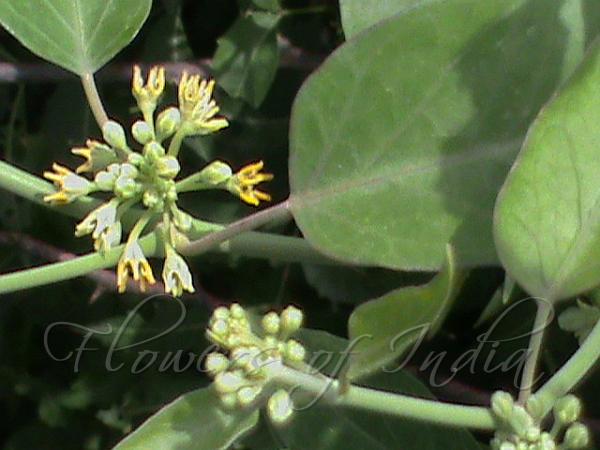|
| Cork Swallow-Wort |
|

|

| File size | 91596 |
| Original date | 8/10/14 10:57 AM |
| Resolution | 640 x 480 |
| Flash | Flash did not fire, auto |
| Focal length | 6.2mm |
| Exposure time | 1/215s |
| Aperture | 2.8 |
| Focus Distance | |
| Metering Mode | Multi-segment |
| Camera make | SONY |
| Camera model | DCR-SR47E |
| Sensor type |
|
|
|
|
Photo: |
Botanical name: Leptadenia reticulata Family: Apocynaceae (Oleander family)
Synonyms: Cynanchum reticulatum
Synonyms: Cynanchum reticulatum
Cork Swallow-Wort is a twining shrub, with numerous
branches. The stems have a cork-like, deeply cracked bark, hairless
when young. Leaves are leathery, ovate, pointed, hairless above, finely
velvety below. Flowers are greenish-yellow, in lateral or subaxillary
cymes, often with small hairs. Seed-pods may be woody. The external
surface of the root is rough, white or buff coloured with longitudinal
ridges and furrows, and in transverse section, the wide cork, lignified
stone cell layers and medullary rays can be seen. Cork Swallow-Wort is
found in the sub-Himalayan tracts of Punjab and Uttarakhand and
throughout the Deccan peninsula up to an altitude of 900 m and found
particularly in hedges. It is also distributed throughout Mauritius,
Madagascar, Sri Lanka, the Himalayas and Burma.
Medicinal uses: The plant is galactogogue,
cooling, nutritive, aphrodisiac, stimulant, diuretic, and eyetonic.
Useful to cure eye-diseases, seminal debility, general weakness, cough,
dyspnoea, fever, asthma, constipation, sore throat, and gonorrhea.
Extracts of roots and leaves of the plant act as antibacterial and
anti-fungal agent. It promotes health and vigour, improves voice,
alleviates the three dosas vata, pitta and kapha. It also cures eye
diseases, hematemesis, emaciation, cough, dyspnoea, fever and burning
sensation.
The plant is galactogogue,
cooling, nutritive, aphrodisiac, stimulant, diuretic, and eyetonic.
Useful to cure eye-diseases, seminal debility, general weakness, cough,
dyspnoea, fever, asthma, constipation, sore throat, and gonorrhea.
Extracts of roots and leaves of the plant act as antibacterial and
anti-fungal agent. It promotes health and vigour, improves voice,
alleviates the three dosas vata, pitta and kapha. It also cures eye
diseases, hematemesis, emaciation, cough, dyspnoea, fever and burning
sensation.
Medicinal uses:
 The plant is galactogogue,
cooling, nutritive, aphrodisiac, stimulant, diuretic, and eyetonic.
Useful to cure eye-diseases, seminal debility, general weakness, cough,
dyspnoea, fever, asthma, constipation, sore throat, and gonorrhea.
Extracts of roots and leaves of the plant act as antibacterial and
anti-fungal agent. It promotes health and vigour, improves voice,
alleviates the three dosas vata, pitta and kapha. It also cures eye
diseases, hematemesis, emaciation, cough, dyspnoea, fever and burning
sensation.
The plant is galactogogue,
cooling, nutritive, aphrodisiac, stimulant, diuretic, and eyetonic.
Useful to cure eye-diseases, seminal debility, general weakness, cough,
dyspnoea, fever, asthma, constipation, sore throat, and gonorrhea.
Extracts of roots and leaves of the plant act as antibacterial and
anti-fungal agent. It promotes health and vigour, improves voice,
alleviates the three dosas vata, pitta and kapha. It also cures eye
diseases, hematemesis, emaciation, cough, dyspnoea, fever and burning
sensation. | Identification credit: S. Kasim | Photographed in Tamil Nadu. |
• Is this flower misidentified? If yes,